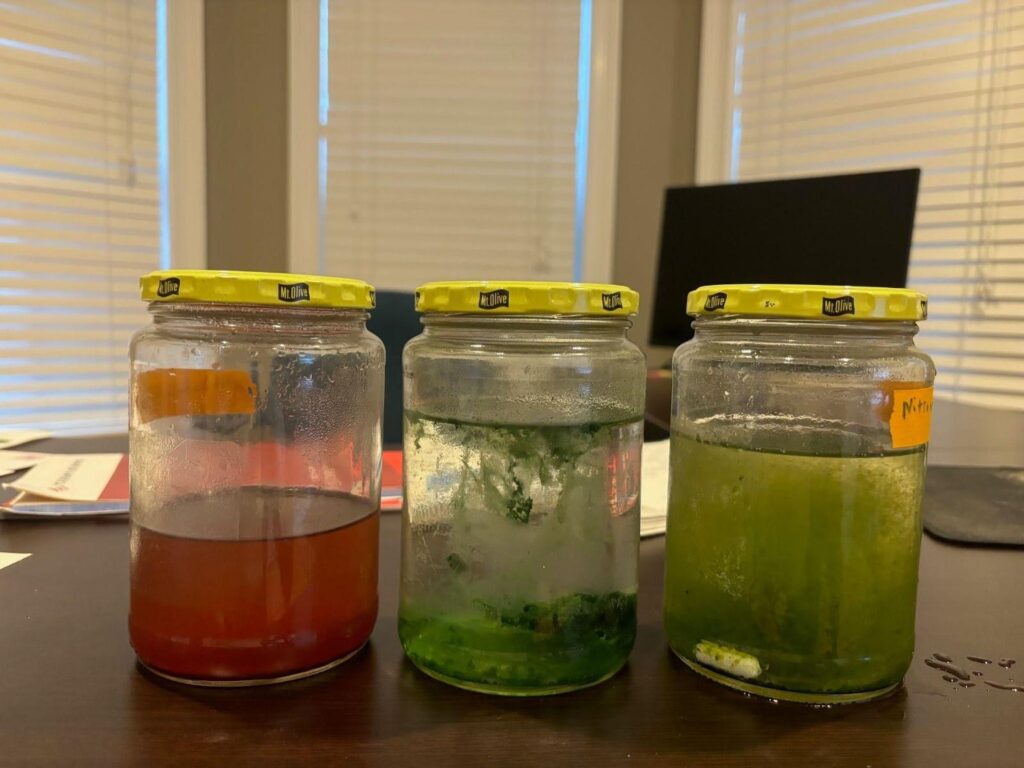What began as a simple assignment for our school science fair as part of the Intro to Science Research elective has since grown into an award-winning research project. We three high school students from Acton Boxborough Regional High School were ultimately selected to compete at the 2024 Massachusetts Science and Engineering Fair (MSEF) at Gillette Stadium on April 5, 2024, where our project, entitled “Septic biogas purification with a microbial filter,” won first place in the category of environmental engineering among hundreds of top projects.

Our team, supported by biology teacher Mr. Aaron Mathieu and research club advisor Mr. Brian Dempsey, set out to tackle a question that joins environmental science, renewable energy, and everyday household systems: how to make biogas a safer, more practical source of small-scale energy.
In a natural process, biogas is produced in any decomposing environment that breaks down organic waste without oxygen, a process known as anaerobic digestion. The resulting gas composition is mostly methane and carbon dioxide, with small amounts of other compounds such as hydrogen sulfide, carbon monoxide, and ammonia. While methane can be used as a fuel for heating or electricity, these other impurities make unfiltered biogas unsafe for domestic use.
Aakarsh recognized the need: People in rural parts of the world, like my extended family in India, use manure and organic waste to generate biogas for heating and cooking. It works, but the systems are often unregulated and unsafe. We thought, why not find a way to make the process cleaner and practical for homes here?
Large-scale filtration systems already exist for industrial uses, but they are too bulky and expensive for individual households. Our idea was to use bacteria as a natural filtering method. Inspired by research on cyanobacteria and carbon capture, we designed a three-stage filtration system in which bacteria “consume” the unwanted gases through their metabolism, leaving behind clean methane that could be used as fuel.
We wanted something that could bridge the gap between rural-scale systems and industrial systems. Our solution uses biology in a way that hasn’t been widely applied to biogas before, as opposed to current chemical and physical means of filtration.

Andrew was in charge of research and the presentation, which required learning about the biogas industry. We’ve all heard about solar, wind, and hydro, but how many people have heard about biogas? It’s really a lesser-known renewable energy that will be crucial to creating a sustainable society.
Aakarsh designed the prototype filter, which consisted of three acrylic tubes connected in series, each containing a different type of bacteria.
- Stage one: Rhodospirillum rubrum, a purple bacterium, converted hydrogen sulfide into solid sulfur and consumed carbon monoxide.
- Stage two: Anabaena, a cyanobacterium, absorbed carbon dioxide through photosynthesis.
- Stage three: Nitrosomonas and Nitrobacter converted ammonia into salts.

The filter was connected to a small tank of food waste to simulate a decomposing, anaerobic environment.
Aaron managed the bacterial cultures. The preparation took weeks of careful experimentation. We had to figure out the right conditions for the bacteria to grow, the right media, the right temperatures. It took a lot of small steps before we could even start testing the filter itself.
Testing was first carried out using an Arduino microcontroller with gas sensors and later with higher grade gas detectors. In multiple trials, the system successfully removed nearly all of the unwanted gases, while maintaining methane concentration. The team also ran a 90-minute continuous test, finding that the filter remained effective over time.
All this hard work paid off at the fairs. After advancing from the high school science fair to the regional competition, our project was selected to compete at MSEF, held at Gillette Stadium, where it won first place in the category of environmental engineering among hundreds of top projects.
Presenting at MSEF was amazing. It wasn’t just about winning, it was about sharing our work with scientists and judges who asked complex questions and gave us thought-provoking feedback. That made the experience even more valuable.

Over the next year after the fair, we have continued to refine our design. We are currently researching additions such as activated carbon filters, nutrient feeders, and pH and temperature sensors to optimize bacterial performance. We also envision applications beyond septic tanks, including farm waste, municipal composting, and even decomposing grass clippings to have an even greater energy production. Potentially, bacterial filtration could also be used for simple air purification. .
The math shows that a family of four could generate up to six kilowatt-hours of electricity a month just from household waste, even assuming a 30% efficiency rate. That’s not enough to power everything, but it’s a meaningful supplement and, more importantly, it’s better for health and the environment than letting methane escape into the atmosphere.
Looking ahead, our team hopes to keep testing, refining, and scaling the project to make renewable energy more accessible. We believe that small-scale innovations can make a global difference.
This project started as a class assignment, but it became something much bigger. We realized that even as high school students, we could take an idea and push it toward a real-world solution.
Aakarsh Tathachar is a senior at ABRHS with an interest in biomedical engineering and artificial intelligence.
Aaron Hong is a senior at ABRHS with an interest in microbiology and environmental science.
Andrew Wu is a senior at ABRHS and wants to pursue environmental science.













